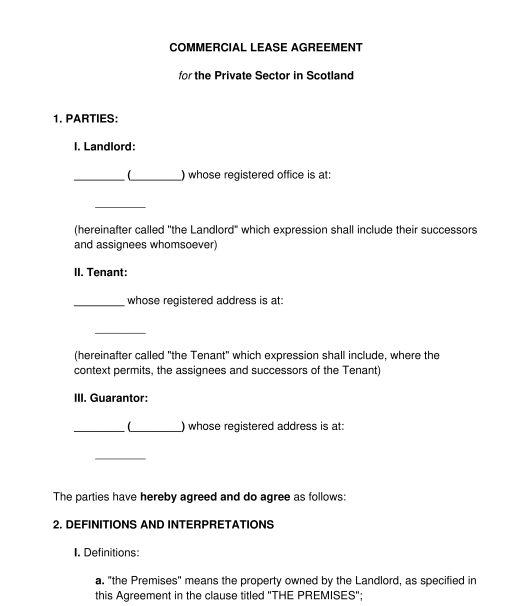 24/09/2025
24/09/2025

Answer a few questions and your document is created automatically.

Your document is ready! You will receive it in Word and PDF formats. You will be able to modify it.

 24/09/2025
24/09/2025
 Word and PDF
Word and PDF
 20 to 30 pages
20 to 30 pages



A commercial lease is a contract between a commercial landlord and a tenant, permitting the tenant to rent premises for business purposes (for example: shops, restaurant, a bar, a convenience store).
A commercial lease specifies the rights and responsibilities of the landlord and the tenant, as well as the contract's duration.
This commercial lease relates to Scotland only. Other documents should be used for England and Wales, and Northern Ireland.
Commercial Leases have different types depending the structure, length and purpose of the lease. Broadly speaking, there are two classes of Commercial Leases, namely Gross Leases and Net Leases.
In addition to these two classes of lease, there are also:
The key difference between commercial and residential leases is their purpose: commercial leases are for business premises, while residential leases are for living spaces like houses or flats.
Legally, commercial leases are treated differently, as they involve experienced business parties with fewer statutory protections for tenants. Courts are less likely to intervene if a commercial tenant finds the lease terms unfair, as both parties are expected to negotiate terms more effectively than in residential leases.
For residential leases in Scotland, use the Private Residential Tenancy Agreement. Other documents should be used for England and Wales, and Northern Ireland.
No, it is not mandatory to have a commercial lease in Scotland, however it is common and highly recommended.
While verbal agreements can be legally binding, having a written lease provides clear terms, protects both parties, and helps manage disputes.
In Scotland, commercial leases can have a maximum duration of 175 years. After this period, the lease will automatically expire, even if a longer term is stated in the lease agreement.
In practice, commercial leases tend to be around 1 to 3 years for shorter leases, while longer leases are usually up to 25 years. On average, commercial leases are usually between 8 to 10 years.
The parties involved are the lessor and the lessee. The lessor refers to the landlord, who owns the property, while the lessee is the tenant renting the property. Another party that may be involved in a commercial lease is a guarantor.
A guarantor is a third party who guarantees the tenant's obligations, agreeing to fulfil the tenant's responsibilities (e.g., paying rent) if the tenant defaults.
Both the landlord and tenant must sign the lease agreement and it is advisable to have the signatures witnessed. Afterwards, the tenant typically pays the first installment of any rent or deposit agreed upon.
Leases of over 20 years must be registered with the Registers of Scotland. Registration of leases under 20 years is not compulsory, but registration is advisable as it provides protection by ensuring the lease is enforceable if the property is sold and provides transparency as well as legal certainty.
Registration of a lease means that the lease is formally recorded with the registration authority (i.e. Registers of Scotland) and grants it legal status. The registration of the lease offers more protection for the tenant as the details of the lease are publicly available on the property title.
If the lease includes a premium or the rent is above a certain threshold, the tenant may be liable for Land and Buildings Transaction Tax. The tenant must file an LBTT return and pay any tax due to Revenue Scotland according to the Land and Buildings Transaction Tax (Scotland) Act 2013. This information can be found on the Registers of Scotland.
Lastly, both parties should ensure that the lease complies with relevant laws, and once the lease is signed, rent is paid and formalities are completed, the landlord will typically hand over the premises keys to the tenant.
It is necessary to register commercial leases in the Land Register of Scotland if they are longer than 20 years. Registration establishes clear notice of the lease to all parties involved, creating records of who owns the property and any relevant matters affecting the property.
Registration could also be beneficial to tenants in that they make the lease enforceable (i.e. the tenant can rely on the legal protections in the lease) against any future property owners. That is, if the landlord decides to sell the property, the new owner is legally obligated to honor the terms of the registered lease.
Although having a witness is not necessary for leases, it is generally advisable to have the lease witnessed to ensure its enforceability and to prevent potential legal issues in the future.
The tenant is only permitted to use the premises for the purposes specified in the commercial lease agreement.
If a tenant wishes to use the premises for a different purpose than what is stated in the lease, they would need to seek the landlord's consent.
A commercial lease can be guaranteed in a number of ways, which include:
A commercial lease should include:
In Scotland, the law of commercial leases is largely based on common law and not statute and therefore not many Acts of Parliament which are applicable to the regulation and creation of commercial leases.
The Town and Country Planning (Scotland) Act 1997
The Town and Country Planning (Use Classes) (Scotland) Order 1997
The Planning (Hazardous Substances) (Scotland) Act 1997
The Planning (Listed Buildings and Conservation Areas) Act 1997
The Planning (Consequential Provisions) (Scotland) Act 1997
The Building (Scotland) Acts 1959 and 1970
Land and Buildings Transaction Tax (Scotland) Act 2013.
You fill out a form. The document is created before your eyes as you respond to the questions.
At the end, you receive it in Word and PDF formats. You can modify it and reuse it.
Guides to help you
Commercial Lease (Scotland) - Template - Word & PDF
Country: United Kingdom